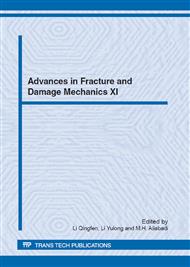p.397
p.401
p.405
p.409
p.413
p.417
p.421
p.425
p.429
Extended Finite Element Method for Fracture Mechanics and Mesh Refinement Controlled by Density Function
Abstract:
This paper discusses the combination of element enrichment by mesh refinement controlled by density function with the extended finite element method and its application in fracture mechanics. Extended finite element method (XFEM) is an effective numerical method for solving discontinuity problems in the finite element work frame. A numerical example of fracture mechanics is analyzed at the end of this paper to show the application of the above method.
Info:
Periodical:
Pages:
413-416
Citation:
Online since:
November 2012
Authors:
Price:
Сopyright:
© 2013 Trans Tech Publications Ltd. All Rights Reserved
Share:
Citation:


